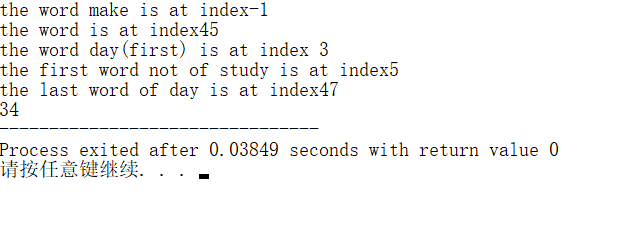【C++】C++string类总结
一、string的初始化
首先,为了在程序中使用string类型,必须包含头文件 <string>。如下:
#include <string>
注意这里不是string.h,string.h是C字符串头文件。
string类是一个模板类,位于名字空间std中,通常为方便使用还需要增加:
using namespace std;
声明一个字符串变量很简单:
string str;
测试代码:
|
1
2
3
4
5
6
7
8
9
10
11
12
13
14
15
16
17
18
19
20
21
22
23
24
|
#include <iostream>#include <string>using namespace std;int main ( ){ string str; //定义了一个空字符串str str = "Hello world"; // 给str赋值为"Hello world" char cstr[] = "abcde"; //定义了一个C字符串 string s1(str); //调用复制构造函数生成s1,s1为str的复制品 cout<<s1<<endl; string s2(str,6); //将str内,开始于位置6的部分当作s2的初值 cout<<s2<<endl; string s3(str,6,3); //将str内,开始于6且长度顶多为3的部分作为s3的初值 cout<<s3<<endl; string s4(cstr); //将C字符串作为s4的初值 cout<<s4<<endl; string s5(cstr,3); //将C字符串前3个字符作为字符串s5的初值。 cout<<s5<<endl; string s6(5,'A'); //生成一个字符串,包含5个'A'字符 cout<<s6<<endl; string s7(str.begin(),str.begin()+5); //区间str.begin()和str.begin()+5内的字符作为初值 cout<<s7<<endl; return 0;} |
程序执行结果为:
Hello world
world
wor
abcde
abc
AAAAA
Hello
二、string的比较等操作
你可以用 ==、>、<、>=、<=、和!=比较字符串,可以用+或者+=操作符连接两个字符串,并且可以用[]获取特定的字符。
|
1
2
3
4
5
6
7
8
9
10
11
12
13
14
15
16
17
18
19
20
21
22
|
#include <iostream>#include <string>using namespace std;int main(){ string str; cout << "Please input your name:"<<endl; cin >> str; if( str == "Li" ) // 字符串相等比较 cout << "you are Li!"<<endl; else if( str != "Wang" ) // 字符串不等比较 cout << "you are not Wang!"<<endl; else if( str < "Li") // 字符串小于比较,>、>=、<=类似 cout << "your name should be ahead of Li"<<endl; else cout << "your name should be after of Li"<<endl; str += ", Welcome!"; // 字符串+= cout << str<<endl; for(int i = 0 ; i < str.size(); i ++) cout<<str[i]; // 类似数组,通过[]获取特定的字符 return 0;} |
程序执行结果为:
Please input your name:
Zhang↙
you are not Wang!
Zhang, Welcome!
Zhang, Welcome!
上例中,“ cout<< str[i]; ”可换为: cout<< str.at(i);
三、string特性描述
可用下列函数来获得string的一些特性:
int capacity()const; //返回当前容量(即string中不必增加内存即可存放的元素个数)
int max_size()const; //返回string对象中可存放的最大字符串的长度
int size()const; //返回当前字符串的大小
int length()const; //返回当前字符串的长度
bool empty()const; //当前字符串是否为空
void resize(int len,char c); //把字符串当前大小置为len,多去少补,多出的字符c填充不足的部分
测试代码:
|
1
2
3
4
5
6
7
8
9
10
11
12
13
14
15
16
17
18
19
20
21
22
|
#include <iostream>#include <string>using namespace std;int main(){ string str; if (str.empty()) cout<<"str is NULL."<<endl; else cout<<"str is not NULL."<<endl; str = str + "abcdefg"; cout<<"str is "<<str<<endl; cout<<"str's size is "<<str.size()<<endl; cout<<"str's capacity is "<<str.capacity()<<endl; cout<<"str's max size is "<<str.max_size()<<endl; cout<<"str's length is "<<str.length()<<endl; str.resize(20,'c'); cout<<"str is "<<str<<endl; str.resize(5); cout<<"str is "<<str<<endl; return 0;} |
程序执行结果为:
str is NULL.
str is abcdefg
str's size is 7
str's capacity is 15
str's max size is 4294967294
str's length is 7
str is abcdefgccc
str is abcde
四、string的查找
由于查找是使用最为频繁的功能之一,string提供了非常丰富的查找函数:(注:string::npos)
size_type find( const basic_string &str, size_type index ); //返回str在字符串中第一次出现的位置(从index开始查找),如果没找到则返回string::npos
size_type find( const char *str, size_type index ); // 同上
size_type find( const char *str, size_type index, size_type length ); //返回str在字符串中第一次出现的位置(从index开始查找,长度为length),如果没找到就返回string::npos
size_type find( char ch, size_type index ); // 返回字符ch在字符串中第一次出现的位置(从index开始查找),如果没找到就返回string::npos
注意:查找字符串a是否包含子串b,不是用 strA.find(strB) > 0 而是 strA.find(strB) != string:npos 这是为什么呢?(初学者比较容易犯的一个错误)本部分参考自web100与luhao1993
先看下面的代码
int idx = str.find("abc");
if (idx == string::npos);
上述代码中,idx的类型被定义为int,这是错误的,即使定义为 unsigned int 也是错的,它必须定义为 string::size_type。npos 是这样定义的: static const size_type npos = -1; 因为 string::size_type (由字符串配置器 allocator 定义) 描述的是 size,故需为无符号整数型别。因为缺省配置器以型别 size_t 作为 size_type,于是 -1 被转换为无符号整数型别,npos 也就成了该型别的最大无符号值。不过实际数值还是取决于型别 size_type 的实际定义。不幸的是这些最大值都不相同。事实上,(unsigned long)-1 和 (unsigned short)-1 不同(前提是两者型别大小不同)。因此,比较式 idx == string::npos 中,如果 idx 的值为-1,由于 idx 和字符串string::npos 型别不同,比较结果可能得到 false。因此要想判断 find()等查找函数的结果是否为npos,最好的办法是直接比较。
测试代码:
|
1
2
3
4
5
6
7
8
9
10
11
12
13
14
15
16
17
18
19
20
|
#include<iostream>#include<string>using namespace std;int main(){ int loc; string s="study hard and make progress everyday! every day!!"; loc=s.rfind("make",10); cout<<"the word make is at index"<<loc<<endl;//-1表示没找到 loc=s.rfind("make");//缺省状态下,从最后一个往前找 cout<<"the word make is at index"<<loc<<endl; loc=s.find_first_of("day"); cout<<"the word day(first) is at index "<<loc<<endl; loc=s.find_first_not_of("study"); cout<<"the first word not of study is at index"<<loc<<endl; loc=s.find_last_of("day"); cout<<"the last word of day is at index"<<loc<<endl; loc=s.find("day");//缺陷状态下从第一个往后找 cout<<loc; return 0;} |
运行结果:

五、其他常用函数
string &insert(int p,const string &s); //在p位置插入字符串s
string &replace(int p, int n,const char *s); //删除从p开始的n个字符,然后在p处插入串s
string &erase(int p, int n); //删除p开始的n个字符,返回修改后的字符串
string substr(int pos = 0,int n = npos) const; //返回pos开始的n个字符组成的字符串
void swap(string &s2); //交换当前字符串与s2的值
string &append(const char *s); //把字符串s连接到当前字符串结尾
void push_back(char c) //当前字符串尾部加一个字符c
const char *data()const; //返回一个非null终止的c字符数组,data():与c_str()类似,用于string转const char*其中它返回的数组是不以空字符终止,
const char *c_str()const; //返回一个以null终止的c字符串,即c_str()函数返回一个指向正规C字符串的指针, 内容与本string串相同,用于string转const char*
测试代码:
|
1
2
3
4
5
6
7
8
9
10
11
12
13
14
15
16
17
18
19
20
21
|
#include <iostream>#include <string>using namespace std;int main(){ string str1 = "abc123defg"; string str2 = "swap!"; cout<<str1<<endl; cout<<str1.erase(3,3)<<endl; //从索引3开始的3个字符,即删除掉了"123" cout<<str1.insert(0,"123")<<endl; //在头部插入 cout<<str1.append("123")<<endl; //append()方法可以添加字符串 str1.push_back('A'); //push_back()方法只能添加一个字符 cout<<str1<<endl; cout<<str1.replace(0,3,"hello")<<endl; //即将索引0开始的3个字符替换成"hello" cout<<str1.substr(5,7)<<endl; //从索引5开始7个字节 str1.swap(str2); cout<<str1<<endl; const char* p = str.c_str(); printf("%s\n",p); return 0;} |
程序执行结果为:
abc123defg
abcdefg
123abcdefg
123abcdefg123
123abcdefg123A
helloabcdefg123A
abcdefg
swap!
swap!
【C++】C++string类总结的更多相关文章
- 标准库String类
下面的程序并没有把String类的所有成员方法实现,只参考教程写了大部分重要的成员函数. [cpp] view plain copy #include<iostream> #include ...
- 自己实现简单的string类
1.前言 最近看了下<C++Primer>,觉得受益匪浅.不过纸上得来终觉浅,觉知此事须躬行.今天看了类类型,书中简单实现了String类,自己以前也学过C++,不过说来惭愧,以前都是用C ...
- C++ string类的实现
c++中string类的实现 今天面试被考到了, 全给忘记了!!! //string类的实现 #include <iostream> #include <string.h> ...
- String类的功能
String类 标红的为较少出现的 1.判断功能 boolean equals(Object obj) :比较字符串内容是否相同,区分大小写 boolean equalsIg ...
- java基础复习:final,static,以及String类
2.final 1)为啥String是final修饰的呢? 自己答: 答案: 主要是为了“效率” 和 “安全性” 的缘故.若 String允许被继承, 由于它的高度被使用率, 可能会降低程序的性能,所 ...
- String类和StringBuffer类的区别
首先,String和StringBuffer主要有2个区别: (1)String类对象为不可变对象,一旦你修改了String对象的值,隐性重新创建了一个新的对象,释放原String对象,StringB ...
- 05_整理String类的Length()、charAt()、 getChars()、replace()、 toUpperCase()、 toLowerCase()、trim()、toCharArray()使用说明
Question: 整理String类的Length().charAt(). getChars().replace(). toUpperCase(). toLowerCase().trim().toC ...
- 标准C++中的string类的用法总结
标准C++中的string类的用法总结 相信使用过MFC编程的朋友对CString这个类的印象应该非常深刻吧?的确,MFC中的CString类使用起来真的非常的方便好用.但是如果离开了MFC框架,还有 ...
- String类常用方法
1.String类的特点,字符串一旦被初始化就不会被改变. 2.String对象定义的两种方式 ①String s = "affdf";这种定义方式是在字符串常量池中创建一个Str ...
- 运用String类实现一个模拟用户登录程序
package Test; import java.util.Scanner; // 模拟用户登录程序 // 思路: // 1.用两个String类分别接收用户名和密码 // 2.判断输入的用户名和密 ...
随机推荐
- Spring boot 线上部署
1.修改Spring Boot 1.添加:spring-boot-maven-plugin 插件 <build> <plugins> <plugin> <gr ...
- WPF 开源项目
Modern UI for WPF :http://mui.codeplex.com/ 利用Wpf实现Win8 Modern样式的开源项目wpf toolkit :http://wpftoolkit. ...
- pagination.js 使用
pagination.js 使用方式 $('.paginationjs').pagination({ dataSource: 'DetailImage?handler=Search', locator ...
- for XML path 转义
select (SELECT 'ab<&c' FOR XML PATH(''),TYPE).value('.','NVARCHAR(MAX)')
- 在 Linux 系统中读取 GBK 编码的文档
Linux 系统中,默认使用 UTF-8 编码.有时,我们下载的一些文件(比如 TXT 电子书,中文字幕等)使用了 GBK 编码,这样,当我们读取这些文件时,就会看到乱码.一般来说,有两种解决办法. ...
- 【TFS 2010配置】总是提示:Error [ System Checks ] TF255466
服务器环境: Windows Server 2008 软件环境: 安装了360杀毒软件 以下为解决方案: 在验证是否可以安装 SharePoint 时的提示,Error [ System Checks ...
- Windows下安装配置Flutter
Flutter是谷歌的移动UI框架,可以快速在iOS和Android上构建高质量的原生用户界面. Flutter可以与现有的代码一起工作.在全世界,Flutter正在被越来越多的开发者和组织使用,并且 ...
- Java可视化日历(Date类、DATe Format类、Calendar类综合运用),开发可视化日历小程序
Java时间日期类综合运用,开发可视化日历小程序 由键盘输入指定格式的日期,打印这个月的日历 1.代码 import java.text.DateFormat; import java.text.Pa ...
- jar包和war包的介绍和区别
jar包和war包的介绍和区别 Java程序员的日常 关注 做Java开发,jar包和war包接触的挺多的,有必要对它们做一个深入的了解,特总结整理如下: 1.jar包的介绍 JAR(Java Arc ...
- oracle 11g审计关闭,及删除日志
转自https://blog.csdn.net/louwzh/article/details/51274955 环境:Linux redhat6.3 下安装的oracle11g oracle 11g推 ...
